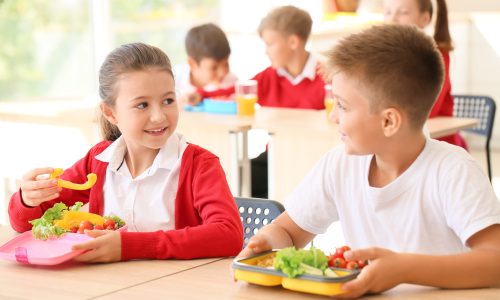There are so many interconnecting factors that influence children’s eating behaviours – it is not all down to the parents.
The most cited reasons for parents wanting to give their children a packed lunch is to provide a healthier meal. They have greater control over what the child eats.
The government guidance on how to safely supply school meals is available.
Government guidance on school meals
Packed lunches provide a unique connection between the school, parent and child. They allow for open communication between the parent and child about food preferences. Studies have found that children have more control over the content of their packed lunch than the parents! (Elsevier 2018).
However, only 1.6% of packed lunches meet the food standards that school meals must adhere to (Evans et al 2020). There is a common misconception that school meals are unhealthier than packed lunches.
Whereas school meal menus allow the child to make their own healthy food choices about their lunch, and the parent can rest easy knowing all choices adhere to the government healthy eating guidelines.
School meals can offer a wider range of nutritionally balanced food to the children, without adding extra stress to parents who are already time-poor!
An increasing amount of food that children eat, is outside the home – stressing the importance of nutrient-dense options available at school.
We all know how fussy children can be…!
Children establish food preferences and dietary habits very early on in life. In fact, some studies show the mother’s diet while pregnant will impact the baby’s future likes and dislikes!
Children are actually biologically programmed to prefer sweet and salty flavours during their early years. Sweetness increases the palpability of food and therefore increases consumption! But you can have too much of a good thing! High sugar intake is directly linked to the increasing obesity epidemic we see in our school children.
According to Public Health England, more than 1 in 5 reception children are overweight or obese. This increases to 1 in 3 by the time they are 10-11 years old.

Food neophobia
Another infant behaviour is food neophobia. The rejection of unknown foods is a normal developmental phase that typically peaks around 2-6 years of age. Food neophobia should decrease as they get older and have more exposure to new foods. The most commonly rejected food is vegetables, due to their slightly bitter taste.
Offer healthy food choices
Studies show that repeated exposure to foods, such as vegetables, is the best way to promote healthy eating choices and diverse intake of food as they get older. This is where parents’ patience comes in handy, as infants may need up to 15 exposures to the same food before they develop trust in it, followed by an additional 10-15 exposures before they start to like the food.
The likelihood of a food being offered this much depends on the parents’ preferences and whether it is something they regularly have in the house. Whereas having meals outside the home, like school meals, exposes children to different dietary patterns and ingredient combinations.
Repeat exposure to new foods has also been shown to develop social skills. Children learn it’s OK to take a little while to get used to something.
How parents can help
The parental role in food choices is complex and puts a lot of responsibility on their shoulders. Research shows they should exert some control over their child’s dietary choices, but should not go as far as to restrict any foods. Restriction has been scientifically proven to promote excessive consumption of the same food later in life, which often causes excessive weight gain.
One of the most successful interventions in child dietary decisions is covert control. This is a method of controlling a child’s food intake in a way that cannot be detected by the child. For example, unhealthy foods are not forbidden, but they are just not accessible at home or school. This type of parenting does not make the child feel restricted and will encourage healthier choices later in life.
This type of gentle parental control on meal choices can be facilitated by schools. Our online payment system can display pictures and descriptions of meals so parents and pupils can make decisions together. They can also display a calendar of the rotating meal cycle, so parents can plan ahead.
How we can help
Our interactive Classroom Edition system, allows children to choose their meal in class each morning. All parents need to do is top-up their online dinner money account. This encourages children’s autonomy and decision-making skills. Parents can check the payment history online and have discussions with their children about their food choices.
To find out how the Dinner Money module can help your school, call us on 02380 016563.


